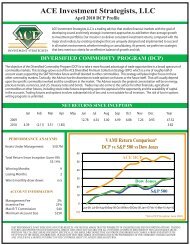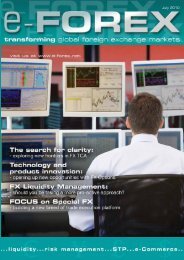You also want an ePaper? Increase the reach of your titles
YUMPU automatically turns print PDFs into web optimized ePapers that Google loves.
Eric Burgener<br />
Market Forces Driving Change<br />
The conventional approach to DR was to periodically<br />
ship copies of backup tapes to remote locations, where<br />
they were often stored for years, to ensure data<br />
recovery in the event of catastrophic disasters which<br />
may shut down primary sites. In the world of DR,<br />
two key metrics govern recovery capabilities: recovery<br />
point objective (RPO) and recovery time objective<br />
(RTO). RPO defines the minimum acceptable level<br />
of data loss (e.g. no more than 24 hours, no more<br />
than 4 hours, etc.) per recovery event, while RTO<br />
defines the maximum acceptable time to recovery<br />
(e.g. data and/or applications restored and running<br />
within 8 hours, etc.).<br />
Remote recoveries from tape generally exhibit lax<br />
RPO and RTO. By the time tapes are stored at<br />
a remote location, the data may already be<br />
several days to a week old, and recovery can<br />
easily require several days to a week. Data is<br />
growing at unprecedented rates, and evolving<br />
business and regulatory mandates are driving<br />
ever more stringent recovery requirements.<br />
For most critical application environments,<br />
a tape-based DR approach just can’t meet<br />
these requirements, putting businesses at<br />
risk for lost revenue, poor customer service,<br />
and, in certain extreme cases, overall<br />
business viability. These market forces<br />
are driving many FX brokers to reevaluate<br />
how they plan for DR.<br />
>>><br />
Planning for Effective DR<br />
There are four critical planning steps that FX brokers<br />
must take in either setting up a DR plan for the first<br />
time or re-evaluating their pre-existing plans:<br />
Step 1: Understand business priorities<br />
While FX brokers have a number of business<br />
processes, certain ones are more critical than others.<br />
Generally, any business processes that are directly<br />
related to revenue generation or customer support are<br />
deemed critical. To focus in on areas for which a<br />
recovery plan must truly exist, it helps to: 1)<br />
understand the time-sensitivity of recovery and how it<br />
relates to business priorities; and 2) identify the<br />
impacts of failures, quantifying them in terms of<br />
dollar amounts (e.g. revenue lost per hour, etc.) where<br />
possible. Create a prioritized list that includes all<br />
major business process areas, and then map those<br />
business processes to the relevant supporting IT<br />
infrastructure. The end goal of this exercise is to have<br />
a list of applications, servers, and storage that must be<br />
available to support each business process.<br />
Step 2: Assess your recovery requirements<br />
Once major business process areas have been<br />
prioritized in terms of their criticality to the business,<br />
you will know which ones need to be focused on first.<br />
The next step is to determine the business impact of<br />
longer versus shorter recovery times for these key<br />
business processes. Recovery tiering is an approach<br />
that is often used when evaluating the recovery<br />
requirements associated with various business<br />
processes. Instead of evaluating and setting recovery<br />
requirements individually for all major business<br />
process areas, a small number of recovery tiers is<br />
defined. Each tier has a set of recovery performance<br />
metrics (e.g. RPO, RTO) that are associated with all<br />
application environments within that tier. For<br />
example, you may define three tiers: the highest tier<br />
for your most critical business processes without<br />
which you cannot run your business, a middle tier for<br />
applications that are not critical but still important,<br />
and a lower tier for all other applications.<br />
Keep in mind that it’s not just data recovery you’ll<br />
need to focus on. When you have to recover from a<br />
major outage, you’ll likely need to recover both data<br />
and applications. Many enterprises implement a DR<br />
plan for just data, assuming that servers and<br />
application environments will be manually rebuilt and<br />
recovered if they need to be. By relying on manual<br />
january 2010 e-FOREX | 113










